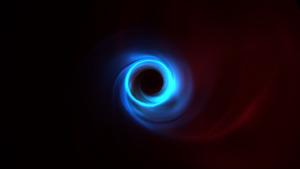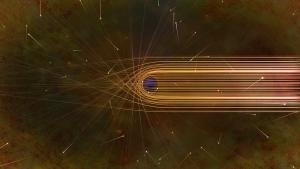Blog
The Shadow Knows
3 October 2020
 L. Medeiros; C. Chan; D. Psaltis; F. Özel; University of Arizona; Institute for Advanced Study
L. Medeiros; C. Chan; D. Psaltis; F. Özel; University of Arizona; Institute for Advanced StudyMost of what we know about black holes is based upon indirect evidence. General relativity predicts the structure of a black hole and how matter moves around it, and computer simulations based on relativity are compared with what we observe, from the accretion disks that swirl around a black hole to the immense jets of material they cast off at relativistic speeds. Then in 2019, radio astronomers captured the first direct image of the supermassive black hole in M87. This allows us to test the limits of relativity in a new and exciting way.
 EHT Collaboration
EHT CollaborationGeneral relativity is a robust scientific theory that has passed numerous scientific tests. But it is not without its problems. Most significantly, it doesn’t play well with the other robust scientific theory, quantum mechanics. Theoretical physicists have proposed several alternatives to general relativity. These models only differ from Einstein’s theory slightly, making them difficult to test. A new paper in Physical Review Letters shows what our observations of the M87 black hole can tell us about these alternative models.1
 Nicolle R. Fuller/NSF
Nicolle R. Fuller/NSFThe fuzzy ringed glow we see in the image of M87* is caused by radio light that has been gravitationally deflected by the black hole. It is essentially a shadow of the black hole with a bright, gravitationally-lensed edge. General relativity predicts the shadow’s size from the mass of the black hole and the brighter and darker regions of the ring from the black hole’s rotation. Alternatives to general relativity would predict slightly different shadow sizes and ring shapes. So a team looked at the M87* data and asked how it constrains alternative theories.
Any alternative to general relativity will make different predictions about how gravity behaves in the extreme regions near a black hole. Some of these alternatives differ more significantly than others. The team found that the observed size of M87* gives these alternative models very little wiggle room. The LIGO and Virgo gravitational wave observatories have confirmed general relativity for the regions of black holes up to about 150 solar masses. This new study improves upon this by a factor of 500. This means that if an alternative theory is correct, its differences must lie only in extremely strong gravitational regions. Stronger than the areas around most black holes.
Soon, astronomers will release a direct image of the supermassive black hole in our own galaxy. When they do, it could narrow down the wiggle room even further. Or it could reveal the shadow of new physics beyond what even Einstein could imagine.
Dimitrios Psaltis et al. “Gravitational Test beyond the First Post-Newtonian Order with the Shadow of the M87 Black Hole.” Physical Review Letters 125.14 (2020): 141104 ↩︎